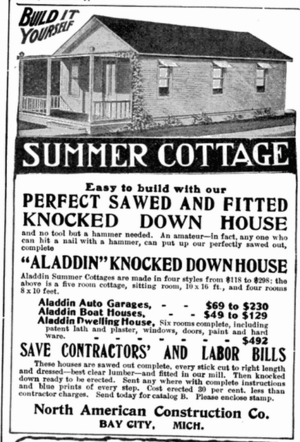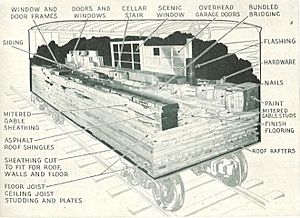Kit houses in Michigan facts for kids

Imagine building a house from a giant LEGO set! That's a bit like what a kit house was. These homes were very popular in Michigan during the early 1900s. Instead of being built piece by piece on site, they came as a kit. All the parts were shipped to you, and then you put them together.
Michigan was a big deal for kit houses. The Aladdin Company, the oldest and longest-lasting kit house maker in North America, started here. They sold houses all over the world! Two other major kit house companies, Lewis and Sterling, were also based in Michigan.
At first, these houses were simple "knock-down" models. But they quickly became full-sized homes with popular designs. Unlike homes built in a factory (pre-fabricated), kit houses arrived as thousands of separate pieces. These pieces had to be put together right where the house would stand. Companies started sending pre-cut wood pieces, which made building much faster. Because of these companies, Michigan became known as the "center of kit-home manufacturing." You can still find these unique homes all over Michigan today. Some are even over 100 years old!
Contents
The Story of Kit Houses in Michigan
The Aladdin Company was one of the first kit house companies. They started in Bay City in 1906. They sold kit houses and other buildings. Aladdin often sold many houses at once to big companies. These companies used the kit houses to create neighborhoods for their workers. By 1918, about 2.4% of all new homes in the US were from Aladdin.
Michigan's Role in Kit Home Production
The Lewis company, also from Bay City, supplied wood for early Aladdin homes. In 1913, Lewis decided to make their own kit houses. Then, in 1915, the International Mill & Timber Company, also in Bay City, started selling kit houses under the Sterling brand.
Bay City was perfect for kit house companies because of its history with the timber industry. They had the tools and skills to process huge amounts of wood. This made it easy for these companies to get all the lumber they needed for their kit homes.
Lasting Legacy of Michigan Kit Houses
Many kit house companies closed during the Great Depression or World War II. But the three Michigan companies kept going for many decades. Lewis and Sterling closed in the 1970s. Aladdin was the last to close, in 1982. This shows how strong and important these Michigan companies were. Other smaller companies, like McClure Company of Saginaw, also made kit houses.
Finding Kit Houses Today
Since Aladdin, Lewis, and Sterling were all in Bay City, you can find many of their kit houses there. Some of the biggest kit house models were built for the company executives. Other Michigan towns also have many kit houses. These include Ann Arbor, Berkley, Clawson, Detroit, Pontiac, Waterford, Flint, and Ypsilanti.
Notable Kit House Collections
In Ypsilanti, you can find "streets lined with houses" built by Michigan companies and their rivals. These homes were later identified by comparing them to old sales catalogs. The Washtenaw Historical Society and Ypsilanti Historical Society have recorded many of these homes. Some have even been nominated for the National Register of Historic Places.
Many kit houses in Michigan were shown in the companies' sales catalogs. These were often "testimonial" homes, meaning happy customers lived in them. Many of these homes are still standing today! Most kit homes are privately owned. But a few are open for the public to see. These include:
- Berkley: Roseland Park Cemetery - an Aladdin Pomona model.
- Waterford: Hatchery House - a Sterling Senator B model.


